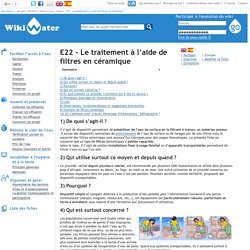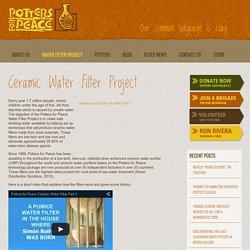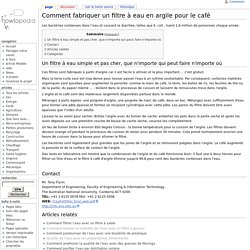

Thirst-Aid – Doing Good To The Last Drop. Roberts. E22 - Le traitement à l’aide de filtres en céramique. 1) De quoi s’agit-il ?

Il s’agit de dispositifs permettant de potabiliser de l’eau de surface en la filtrant à travers un matériau poreux. Il existe des dispositifs centralisés de prétraitement de l’eau de surface ou de forages par de tels filtres mais la majorité des filtres céramiques sont aujourd’hui fabriqués pour des usages domestiques. La présente fiche ne concerne que ce type de filtres domestiques à petites capacités. Selon le type, il s’agit de petites installations fixes à usage familial ou d’appareils transportables permettant de filtrer l’eau où que l’on soit. 2) Qui utilise surtout ce moyen et depuis quand ? Ce procédé, utilisé depuis plusieurs siècles, est recommandé par plusieurs ONG humanitaires et utilisé dans plusieurs pays d’Afrique. notamment au Bénin, au Togo, en Haïti et en Asie. 3) Pourquoi ? 4) Qui est surtout concerné ? Abundant Water's Step by Step Guide to DIY Clay Water Filters (Full How to Video) Engineering for change - Ten low-cost ways to treat water.
Having money helps, but clean water doesn't have to be expensive.

Celebrities like Bill Gates, Matt Damon and, a celebrity to us, Ned Breslin, to name a few, have helped clean rivers, dig wells and install pumps, pipes and other hardware to deliver clean water. Their time and money are well spent because the problem is huge. As we've reported before, as many as 1.8 million people die each year from diarrhea linked to bad water and sanitation, most of them under age 5.
Community-wide water infrastructure is as good as it gets. But until everyone has that, there are other, cheaper clean water solutions. Ceramic filtersClay, sawdust and a plastic bucket can make a water filter that catches dirt and disease-causing microbes. Resources Clay filter guide by the American Red Cross and Sri Lanka Red Cross Society (pdf)Rabbit ceramic water filters by iDE and Potters for Peace EWB-USA's ceramic filter manual (pdf) Manual for establishing a clay filter factory (pdf) Photo courtesy of Solvatten.
Potiers sans frontières - Matériels et des fournitures pour la petite échelle de production de filtres de céramique. Wikiwater - Le traitement à l’aide de filtres en céramique. ACF - Projet de fabrication artisanale de filtres à eau en terre cuite. Potters for Peace - Ceramic Water Filter Project. Every year 1.7 million people, mainly children under the age of five, die from diarrhea which is caused by unsafe water.

The objective of the Potters for Peace Water Filter Project is to make safe drinking water available by helping set up workshops that will produce ceramic water filters made from local materials. These filters are low-tech and low-cost and eliminate approximately 99.88% of water-born disease agents. Since 1998, Potters for Peace has been assisting in the production of a low-tech, low-cost, colloidal silver-enhanced ceramic water purifier (CWP) throughout the world and ceramic water purifiers based on the Potters for Peace technology package are now produced at over 50 independent factories in over 30 countries.
These filters are the highest-rated product for rural point-of-use water treatment (Smart Disinfection Solutions, 2010). Here is a short video that explains how the filters work and gives some history: The Need is Great. Howtopédia - Comment fabriquer un filtre à eau en argile. De Howtopedia - français.

Les bactéries contenues dans l’eau et causant la diarrhée, telles que E. coli , tuent 1,6 million de personnes chaque année. Un filtre à eau simple et pas cher, que n'importe qui peut faire n'importe où Ces filtres sont fabriqués à partir d'argile car il est facile à utiliser et le plus important ... c'est gratuit. Mais la terre cuite seul est trop dense pour laisser passer l'eau à un rythme souhaitable. Par conséquent, certaines matières organiques sont ajoutées pour augmenter la porosité: comme le marc de café, la terre, les balles de riz, les feuilles de thé ou de la paille, du papier mâché ... - brûlent dans le processus de cuisson et laissent de minuscules trous dans l'argile.
L’argile et le café sont des matériaux largement disponibles partout dans le monde. Mélangez à parts égales: une poignée d'argile, une poignée de marc de café, dans un bac. Laissez-le au soleil pour sécher. Contact Mr. Articles relatés Catégories. Wikipédia - Ceramic water filter. A Victorian ceramic water filter Ceramic water filters are an inexpensive and effective type of water filter, that rely on the small pore size of ceramic material to filter dirt, debris, and bacteria out of water.

Method of action[edit] As with most filtration methods, water is carefully introduced to one side of the filter, which acts to block the passage of anything larger than the pore size. Typically bacteria, protozoa, and microbial cysts are removed but the filters are not effective against viruses since they are small enough to pass through to the other "clean" side of the filter. Ceramic water filters (CWF) may be treated with silver in a form that will not leach away. Ceramic filtration does not remove chemical contaminants per se. The two most common types of ceramic water filter are pot type and candle type filters. Contaminants larger than the minute holes of the ceramic structure will remain in the top half of the unit.